博文
Open Access ‖ 季节差异下城市蓝绿空间的老年心理健康恢复性效应—基于空间行为的实证 (2025年第2期)
||
✦ CSCD 核心库收录期刊
✦ CNKI 全文收录期刊
✦ ProQuest 收录期刊
✦ Wanfang 收录期刊
✦ SciOpen全文收录期刊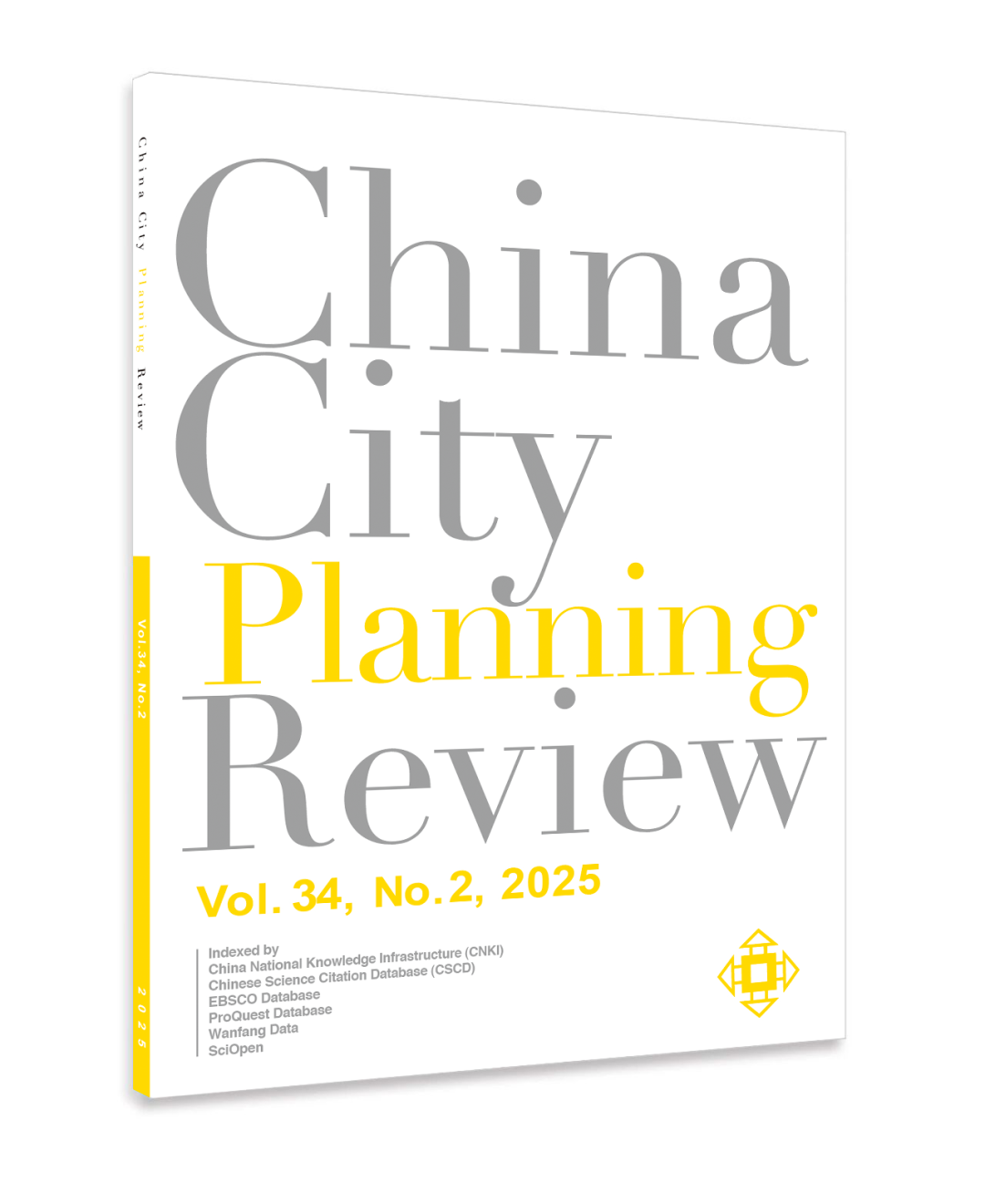
文章题目
季节差异下城市蓝绿空间的老年心理健康恢复性效应—基于空间行为的实证
Restorative Effects of Blue-Green Spaces on the Elderly’s Mental Health Under Seasonal Variations: An Empirical Study in Changchun from the Spatial-Behavioral Perspective
作者
冷红 闫天娇 袁青 ‖ Leng Hong, Yan Tianjiao, Yuan Qing
文章介绍
心理健康问题越来越受到社会各界的关注。城市蓝绿空间的心理健康效应长久以来达到了业内外的广泛共识。目前关于老年群体和蓝绿空间恢复性效应的研究存在两个明显的问题。一方面,基于实验法讨论环境心理健康恢复性效应的研究较为缺乏,且较少涉及老年群体,考虑到其特殊性的实地实验设计更是少之又少;另一方面,现有研究鲜有对特殊气候和季节差异下空间、行为特征和心理健康恢复性效应关系的细致挖掘。因此,研究选定季节划分明显且具冬季特色的长春市,选取具有不同蓝绿特征的6个公园为城市蓝绿空间代表,开展适宜老年群体的实地实验,探索季节差异下蓝绿空间的心理健康恢复性效应结果,并进一步探寻不同空间和行为因子的量化结果,以期将给予实践优化一些启示和引导。
研究选取寒地气候突出并且老龄化问题严峻的典型性城市—长春开展调查。结合长春市林业与园林局网站资料查询以及实地调查,对老年人口密度高的市中心区中所有中等规模和非专项的、开放的蓝绿空间进行筛选,最终确定了六个老年人经常活动的公园为实验地点,包括长春公园、胜利公园、劳动公园、岱山公园、锦江公园和宽城中心公园。
研究将心理健康恢复性效应拆解为认知恢复和情绪改善两方面,考虑到老年群体不能开展过于复杂和施压类实验,研究选择数字广度(DST)测试注意力表现,包括顺背数字广度(DSF)和倒背数字广度(DSB)测试;选择10种常见的情绪表达测试情绪感受,包括 “E1机敏的”、“E2兴奋的”、“E3兴高采烈的”、“E4满足的”和“E5放松的”5种积极情绪,以及“E6紧张的”、“E7有压力的”、“E8厌烦的”、“E9抑郁的”和“E10无聊的”5种消极情绪。研究均通过比较进入空间前后的测试分数差来评估其改善水平。进而研究挖掘了10个空间特征因子和4个行为特征因子的效应结果。
研究首先使用配对样本t检验检测效应的显著性;进而综合DSF和DSB的前后测差异评估认知恢复的总体情况,使用“(ΣΔ积极情绪–ΣΔ消极情绪)/10”评估情绪的总体改善情况,并结合独立样本t检验、Pearson相关性分析和单因素方差分析,讨论不同空间和行为特征的相关关系及其具体的心理健康恢复性效应量。本文使用效应量(effect size)的概念,以横向对比不同特征和季节差异的效应大小。该指标可规避统计上不显著和样本容量不同的问题,常见于心理学研究。其中,通常运用Cohen’d和η2测度差异性比较的效应量,r值测度相关性比较的效应量,这两类指标亦可互相转化。在分析空间和行为特征时,将其统一转化为r值作为效应量的测度。
结果表明:(1)蓝绿空间对老年群体的心理健康恢复性效应始终存在,且非冬季较冬季的认知恢复和积极情绪提升效应更强。(2)空间层面,就蓝绿要素而言,无论在冬季还是非冬季,效应量最大的均是常绿植被面积或植被面积;冬季冰雪雕塑占据第二位,随后是构筑物的认知恢复效应和水体的情绪改善效应;非冬季的恢复性效应排序均是水体可触>构筑物>水体的存在。同时发现,水体对行为的支持性比水体的有无和规模更重要。而关于具有明显行为支持倾向的空间因子,效应量最大的是主路长度,最小的是广场面积。(3)行为层面,冬季和非冬季认知恢复效应较高的行为特征均为停留时长,冬季情绪改善效应较高的是社交属性和行为强度,非冬季则为停留时长和社交属性;而按目的内容划分的行为类型效应差异不显著。
基于空间行为视角的分析与讨论,可相应地提出空间优化和行为促进两方面启示,以期正向干预规划实践,有效提升老年心理健康水平。空间优化方面,未来应将重点置于空间要素的完善和视觉空间的营造。新建公园可统筹现有资源和要素,串联景观叙事线索,老旧公园改造则需在满足功能需求的基础上,统筹价值排序,赋予其文化等附加属性,吸引其前往并激发“地方感”。行为促进方面,对应行为特征和心理健康恢复性效应,以及空间特征和行为特征的相关讨论,冬季蓝绿空间的重点在于中高强度行为的促进,非冬季应着重提升空间的包容性以支持多样化的行为类型,同时提高对社交行为的重视。
Mental health issues have attracted increasing attention from various sectors of society. The psychological health benefits of urban blue-green spaces have long been recognized by both academic and professional communities. However, two major gaps persist in existing research concerning the restorative effects of blue-green spaces on the elderly. First, there is a lack of empirical studies employing experimental methods to examine environmental restorative effects on mental health, particularly studies targeting the elderly population. Given the unique characteristics of this demographic, field experiments specifically designed for older adults remain exceedingly rare. Second, limited research has explored the nuanced relationships among spatial features, behavioral patterns, and psychological restorative outcomes under varying climatic and seasonal conditions.
To address these gaps, this study focuses on Changchun, a city characterized by pronounced seasonal transitions and distinct winter conditions. Six parks with differing blue-green features were selected as representative urban blue-green spaces: Changchun Park, Shengli Park, Laodong Park, Daishan Park, Jinjiang Park, and Kuancheng Central Park. These sites were chosen based on official data from the Changchun Forestry and Landscaping Bureau and field surveys, targeting open, medium-sized, non-specialized green spaces with high elderly user density in the city center. Field experiments were conducted with elderly participants to investigate seasonal variations in the mental health restorative effects of blue-green spaces, and to quantify the influence of various spatial and behavioral factors, aiming to provide practical insights for urban planning and intervention.
The study decomposes psychological restorative effects into two dimensions: cognitive restoration and emotional improvement.
Considering that the elderly are not suited for complex or high-pressure experiments, cognitive function was assessed using the Digit Span Test (DST), including both forward (DSF) and backward (DSB) tasks to evaluate attentional performance. Emotional states were assessed using ten commonly used emotion descriptors: five positive emotions ("E1 Alert", "E2 Excited", "E3 Elated", "E4 Satisfied", and "E5 Relaxed") and five negative emotions ("E6 Tense", "E7 Stressed", "E8 Bored", "E9 Depressed", and "E10 Dull"). The change in test scores before and after entering the spaces served as the basis for evaluating the degree of psychological improvement. Furthermore, the study explored the effects of ten spatial features and four behavioral characteristics.
A paired sample t-test was first employed to examine the statistical significance of observed effects. Cognitive restoration was evaluated using the aggregated differences in DSF and DSB scores, while emotional improvement was measured by the formula: (ΣΔPositive Emotions – ΣΔNegative Emotions) / 10. Independent sample t-tests, Pearson correlation analysis, and one-way ANOVA were used to examine the associations between spatial/behavioral features and their corresponding restorative outcomes. To facilitate cross-comparison of effects across features and seasons, effect size metrics were used, thereby overcoming issues of statistical insignificance and varying sample sizes. Commonly used in psychological research, Cohen’s d and η² were adopted to compare group differences, and r-values were used to measure correlation effects. All indicators were converted to r-values for consistency in evaluating spatial and behavioral effects.
The results reveal the following:
(1). Urban blue-green spaces consistently exhibit restorative effects on elderly mental health, with stronger cognitive and emotional improvements observed in non-winter seasons compared to winter.
(2). At the spatial level, evergreen vegetation area or total vegetation area yielded the largest effect sizes across both winter and non-winter seasons. Ice and snow sculptures ranked second in winter, followed by built structures for cognitive restoration and water features for emotional improvement. In non-winter seasons, the order of restorative effects was tactile water > built structures > presence of water. Notably, the behavioral support provided by water features had greater significance than their presence or scale. Among spatial elements that supported behavior, the length of main pathways showed the largest effect, while plaza area had the smallest.
(3). At the behavioral level, duration of stay was the strongest contributor to cognitive restoration in both winter and non-winter seasons. Emotional improvement in winter was most influenced by social interaction and behavioral intensity, while in non-winter it was driven by duration of stay and social attributes. No significant differences were observed among different types of behavior categorized by purpose.
Drawing from the spatial-behavioral perspective, this study proposes implications for both spatial optimization and behavioral promotion aimed at enhancing elderly mental well-being through urban planning interventions. In terms of spatial optimization, future efforts should focus on refining spatial elements and enhancing visual experiences. New parks should integrate existing resources and landscape narratives, while renovations of older parks should prioritize functionality and introduce added cultural value to foster a sense of place. For behavioral promotion, winter interventions should encourage moderate-to-high intensity activities, whereas non-winter efforts should enhance spatial inclusivity to accommodate diverse behaviors and promote social interaction.
关键词
季节差异;城市蓝绿空间;老年人;心理健康恢复性效应;空间;行为
seasonal variations; blue-green spaces; the elderly; restorative effects on mental health; space; behavior
主要图表
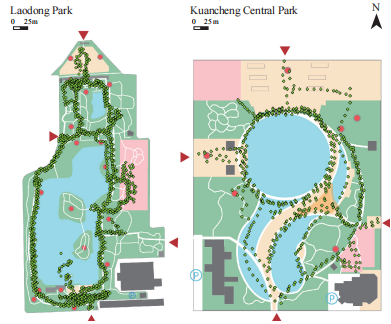
图1 样本公园平面和冬季老年人行为轨迹点示例
Figure 1 Plans of sample parks and examples of behavioral trajectories of the elderly in winter
表1 蓝绿空间的心理健康恢复性效应量(Cohen’d)
Table 1 The restorative effect sizes of blue-green spaces on the elderly’s mental health (unit: Cohen’s d value)
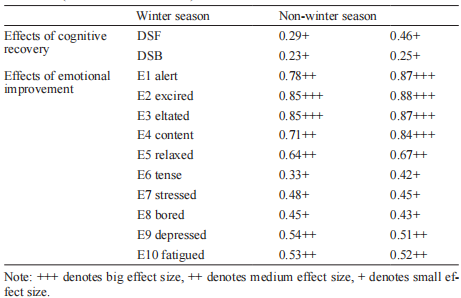
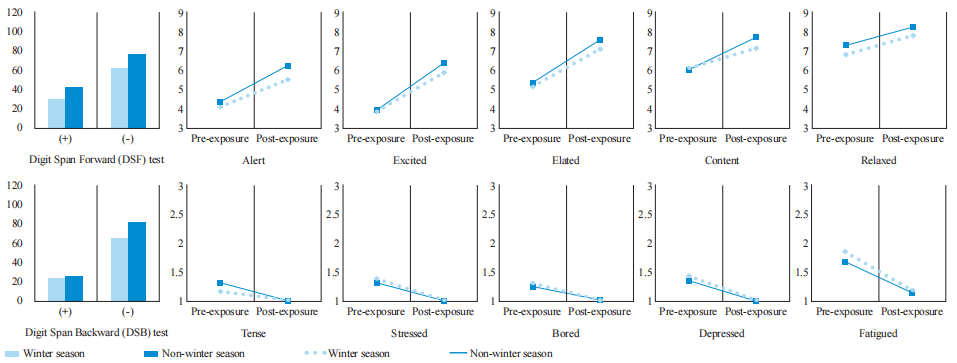
图2 冬季和非冬季认知恢复和情绪改善结果对比
Figure 2 Comparison of the restorative effects of cognitive recovery and emotional improvement between the winter and non-winter seasons
Note: + denotes increase of scores, - denotes no-change or decrease of scores.
表3 不同行为特征下的心理健康恢复性效应量(r)
Table 3 The restorative effect sizes of different behavioral factors on the elderly’s mental health (unit: r value)
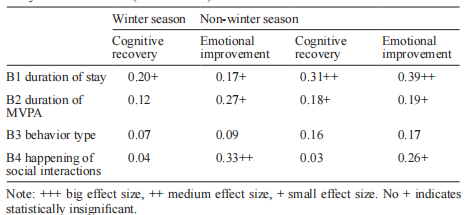
表4 空间特征和行为特征的关系
Table 4 Correlation between the spatial factors of blue-green spaces and the behavioral factors of the elderly

作者简介
冷红,教授,哈尔滨工业大学建筑与设计学院,寒地城乡人居环境科学技术工业和信息化部重点实验室。
Leng Hong, Professor, School of Architecture and Design, Harbin Institute of Technology; Key Laboratory of Science and Technology for Cold Region Rural and Urban Human Settlement Environment, Ministry of Industry and Information Technology, Harbin, P. R. China.
闫天娇,讲师,吉林建筑大学建筑与规划学院,寒地建筑综合节能教育部重点实验室, 吉林省生态智慧城镇创新发展战略研究中心。
Yan Tianjiao, Lecturer, School of Architecture and Planning, Jilin Jianzhu University; Energy Conservation Research Center, Sub-Laboratory of Ministry of Education MOE Key Laboratory of Building Comprehensive Energy Conservation in Cold Region; The Jilin Province Ecological Wisdom Urban Innovation and Development Strategy Research Center, Changchun, P. R. China.
袁青,教授, 哈尔滨工业大学建筑与设计学院,寒地城乡人居环境科学技术工业和信息化部重点实验室。
Yuan Qing, Professor, School of Architecture and Design, Harbin Institute of Technology; Key Laboratory of Science and Technology for Cold Region Rural and Urban Human Settlement Environment, Ministry of Industry and Information Technology, Harbin, P. R. China.
全文链接
http://www.ccprjournal.com.cn/news/10373.htm
欢迎您通过以下方式查询购买:
To purchase the new issue of CCPR, please contact us via:
Tel:010-82819550, Email:ccpr@planning.org.cn.
您也可以登陆我们的网站进行全文浏览:
Or you can also read the papers via:
www.ccprjournal.com.cn
《城市规划(英文版)》
China City Planning Review
网站/Website:www.ccprjournal.com.cn
邮箱/Email:ccpr@planning.org.cn
微博/Weibo:城市规划英文版
微信/Wechat:ccpr_1985
电话/Tel:+86-10-82819550
投稿入口:https://csgy.cbpt.cnki.net/
https://wap.sciencenet.cn/blog-3563286-1497801.html
上一篇:喜报 | 《智能化农业装备学报(中英文)》首次入选“中国科学引文数据库(CSCD)来源期刊”!
下一篇:Open Access ‖ 儿童友好视角下寒地城市通学路径评测及优化策略研究——以哈尔滨市为例 (2025年第1期)